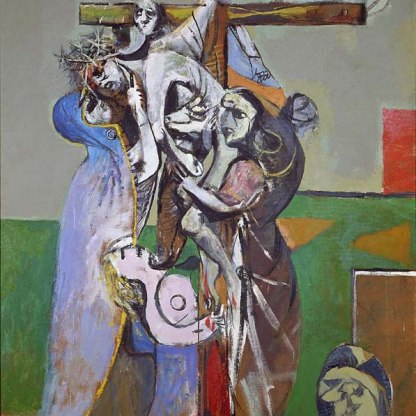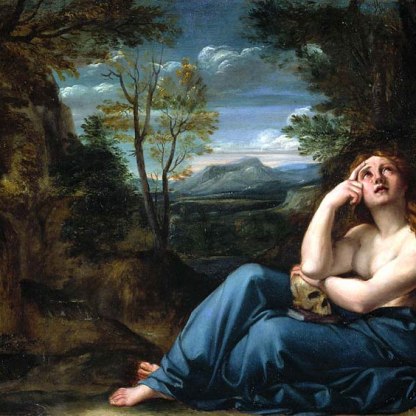Mary Magdalene
At the beginning of the eighth chapter of his Gospel, Luke describes the followers who accompanied Jesus as he travelled and preached:
The twelve were with him, and certain women, which had been healed of evil spirits and infirmities, Mary called Magdalene, out of whom went seven devils,and many others which ministered unto him of their substance.
Elsewhere in the gospels, Mary Magdalene is named as a witness to the Crucifixion (Matthew, 27, 56) and the Resurrection (Matthew, 28, 1–10).
From an early time she was also identified with other women in the New Testament: the 'sinner' who anoints Christ's feet in the house of the Pharisee (Luke, 7, 36–50); with Mary of Bethany, the sister of Martha (Luke, 10, 38–42), and sister of Lazarus, the dead man revived by Christ (John, 11, 1–44); and with the woman taken in adultery, whom Jesus saves from the stones of a hypocritical mob (John, 8, 1–11).
Popular interest in Mary grew in the eleventh century, but her story is told most fully in The Golden Legend, the thirteenth–century collection of saints' lives written by the Italian Dominican monk Jacobus de Voragine. He gives us a detailed description of her background and early character:
Mary Magdalene is so called because of her connection with the town of Magdalum. She was born of noble parents who indeed were of royal descent. Together with her brother Lazarus and sister Martha she owned Magdalum, a fortified town two miles from Genezareth, Bethany, near Jerusalem, and a large part of Jerusalem itself. Since Mary Magdalene was enormously wealthy, and pleasure is the boon companion of affluence, she was as notorious for her abandonment to fleshly pleasures as she was celebrated for her beauty and riches.
She meets Jesus, who 'set her all on fire with love for him, made her one of his closest associates, and lovingly defended her on many occasions'. After Christ's Ascension, she travels to France with her sister Martha and brother Lazarus, where she eventually retires to a life of solitude:
In the meantime blessed Mary Magdalene, wishing to devote herself to heavenly contemplation, withdrew to a barren wilderness where she remained in anonymity for thirty years in a place prepared for her by the hands of angels. In this wilderness there was no water, and there were no trees or grass, nor any comforts of any kind, so that it was clear that our Redeemer had meant to feed her not with earthly foods but with the sweets of Heaven alone. Each day at the seven canonical hours she was lifted in the air by angels and actually heard, with her bodily organs of hearing, the glorious harmonies of the celestial chorus. So, filled day by day with this exquisite heavenly fare, when she was bought back to her cave, she had not the slightest need for bodily nourishment.
The site of her hermitage, Ste-Baume in Provence, and Vézelay, where her relics were brought in the eleventh century, became popular sites of pilgrimage. They remained so, even after 1641 when a scholar in Paris published a treatise entitled Dissertation on the False Arrival in Provence of Lazarus, Maximinus, Magdalene and Martha.
In the seventeenth century, the theme of Mary, wide-eyed and weeping in her grotto, was a popular subject in poetry as well as art. Mary's name, written as 'maudlin', entered the English language as a synonym for 'tearful', eventually coming to describe 'that stage of drunkenness which is characterised by the shedding of tears and effusive displays of affection'.
Other highlight objects you might like
Other pathways and stories you might like
Sign up to our emails
Be the first to hear about our news, exhibitions, events and more…




